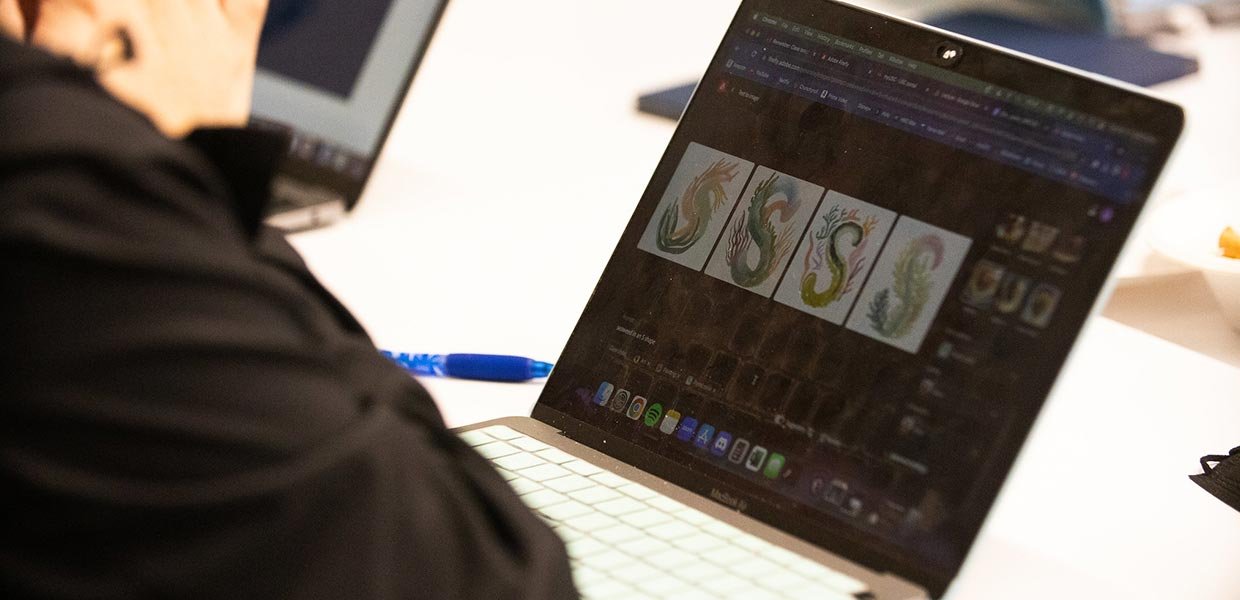“AI may never replace all humans, but it will be my coworker one day,” said Sanika Newaskar, who is studying digital social media.
She and her classmates in JOUR 499: Artificial Intelligence and the Future of Creative Work are learning how the rapid adoption of technology is placing more responsibilities on those who use it.
Taught by Professor of Professional Practice of Journalism Gabriel Kahn, the course examines how AI tools like Bard, ChatGPT and DALL-E, are opening up new frontiers in newsrooms, writers’ rooms and boardrooms.
“The point of this class is to integrate what AI is going to mean for students once they leave USC,” Kahn said. “We examine how new technologies are going to change the picture of future employment and the industries that students are interested in working in.”
Kahn began the fall semester by explaining how large-language models and image generation work, and how to critique both. So, rather than just being on the receiving end of AI, students build a proactive understanding of AI (including its limitations and ethical changes) and gain insights into the ways different industries are integrating AI tools into their workflow.
For one class activity, students in groups of three were given elaborate creative briefs that ranged from creating a 2023 reboot of the sitcom Friends to marketing CBD candies to seniors. They had one hour during which to identify and use AI applications to create artwork, scripts and marketing proposals.
We're trying to figure out how we can use these tools to be more creative, not lazy,” Kahn said. “Students were given a nearly impossible task to produce in an hour, and in the end, produced something pretty amazing. I was shocked that, under deadline, how quickly they put numerous different AI tools to use, some of which they had never worked with before.”

Newaskar, a master’s student, said this was all uncharted territory before taking the class.
“My group was assigned a fictional CBD candy company for older adults that helps them relieve their back pains,” she said. “I was responsible for the video and I used this tool called HeyGen. I gave it a script using ChatGPT and generated an avatar that we featured.”
Newaskar and her group members also used Canva and she recalls being surprised at the censorship built into some of the technologies.
“We could not use the acronym ‘CBD,’ but we could use words like ‘high,’” she said. “Professor Kahn made the assignment fun and prioritized creativity. I enjoyed the fact that he didn’t expect perfect results, but wanted to push us to use as many AI tools as possible to see what we could create.”
Junior journalism major Nick Wald signed up for the course last minute. He was a computer science major before he transferred to USC Annenberg and has always been very interested in tech.
“This course is a really good blend of my interest in journalism and the applications of computer science,” Wald said. “Professor Kahn shared that, in many ways, he has been learning alongside us and that's been really interesting because he’s created an engaging and community-focused class.”
Kahn said his first two takeaways were: the importance of students understanding the mechanics of how AI models are made — not just accepting them at face value — and playing and experimenting with the tools.
“Teaching this class was like stepping into the great unknown,” he said. “I did not know where it would lead and updated the syllabus 100 times during the semester. Even the AI models available to the public changed significantly over the last few months.”
Guest speakers were also an integral part of the class, providing an opportunity for students to dive into real-time case studies with industry leaders such as Founder and CEO of Mission Control Ramsay Brown, Charter CEO Kevin Delaney and Todd Terazzas, founder of startup FBRC.AI. Kahn added it was also critical for students to hear from professionals who have deviated from traditional paths in PR and journalism and are creating AI startups that apply to those fields.
“The guest speakers have been amazing,” Wald said. “This field is such a moving target that sometimes it all seems up in the air until you hear from somebody who's actually working with it.”
While there were no prerequisites for the course, Kahn said the only requirements that proved necessary were curiosity and determination.
“The best thing we can do is bring students together and have them work collaboratively with AI to solve thorny problems,” he said. “It’s been fun, empowering and effective.”
